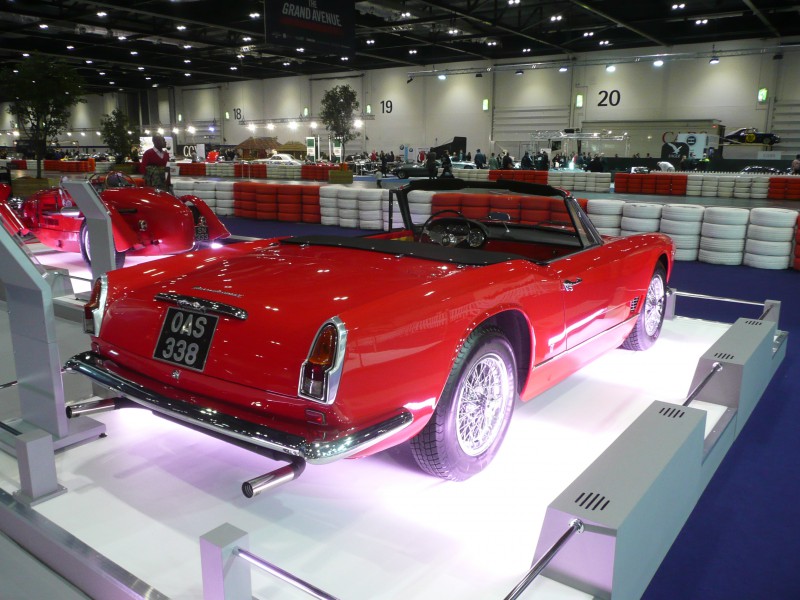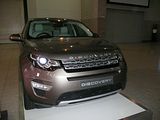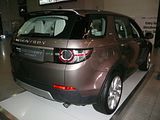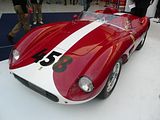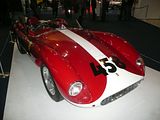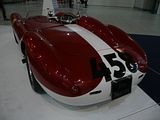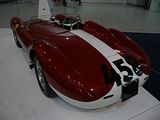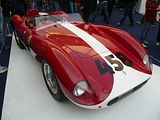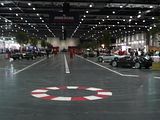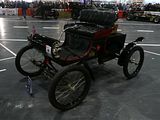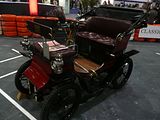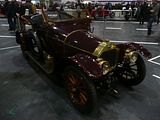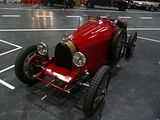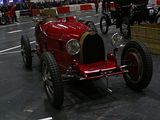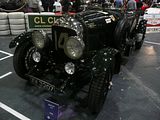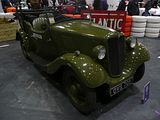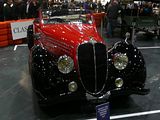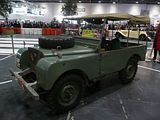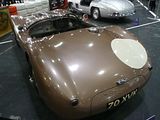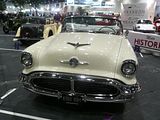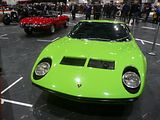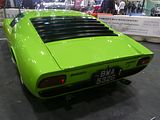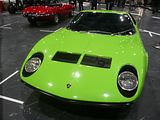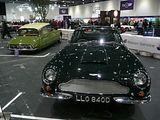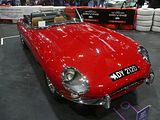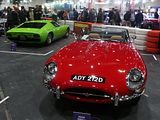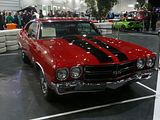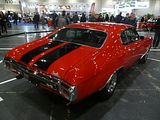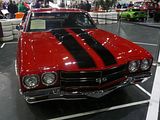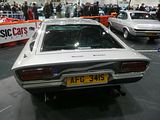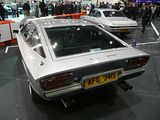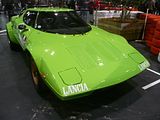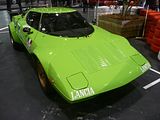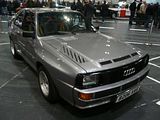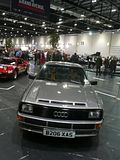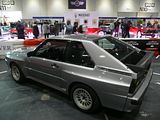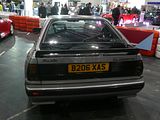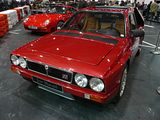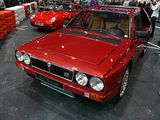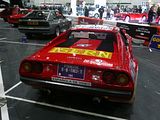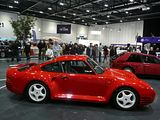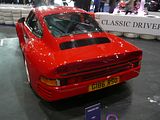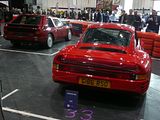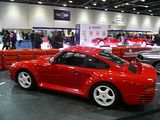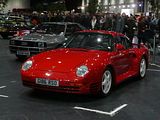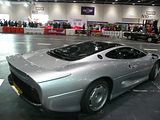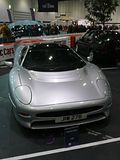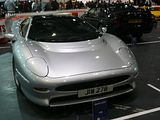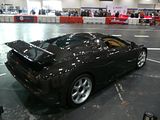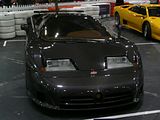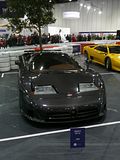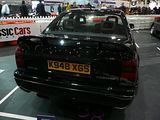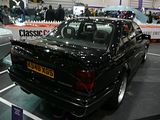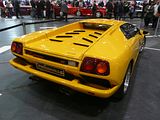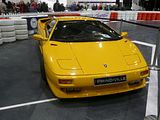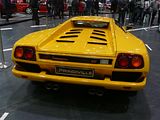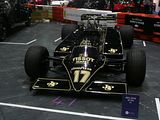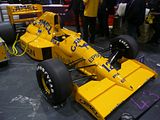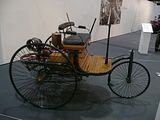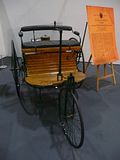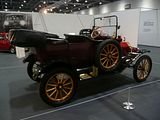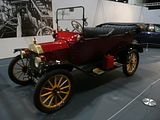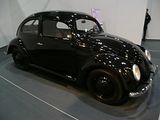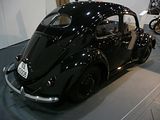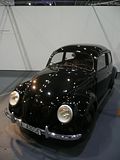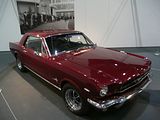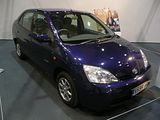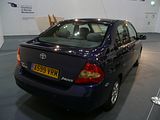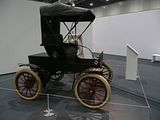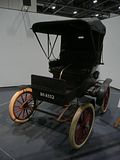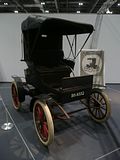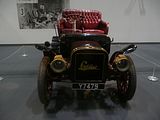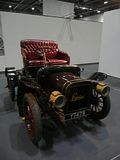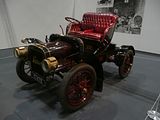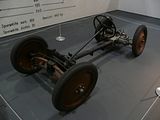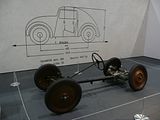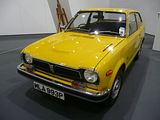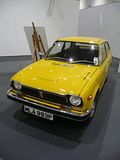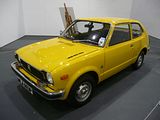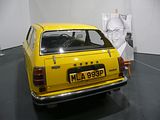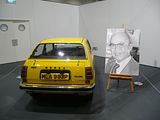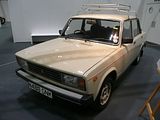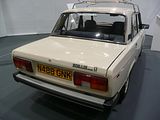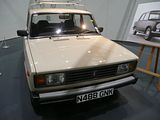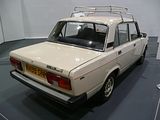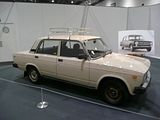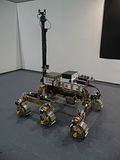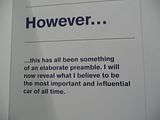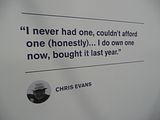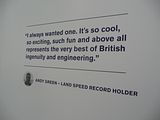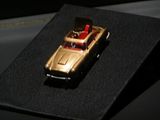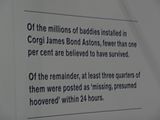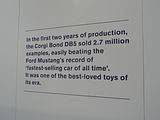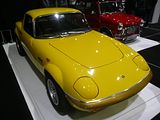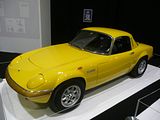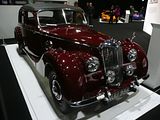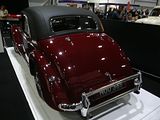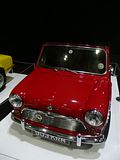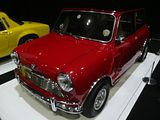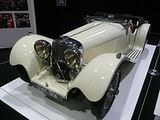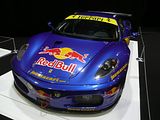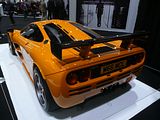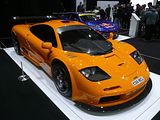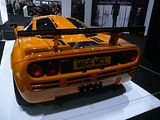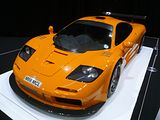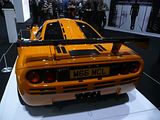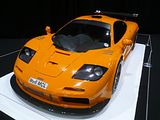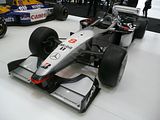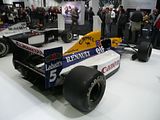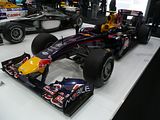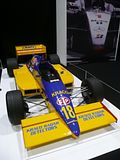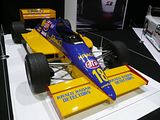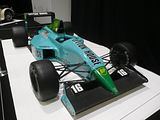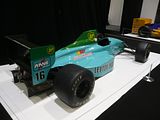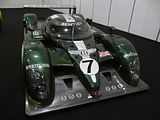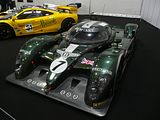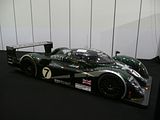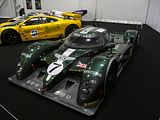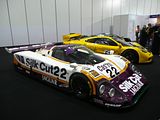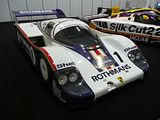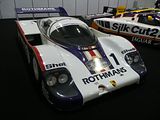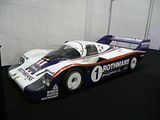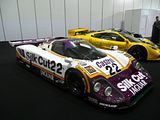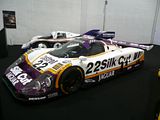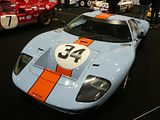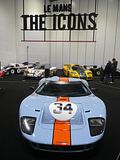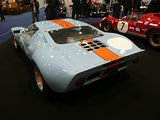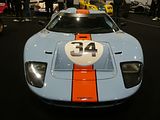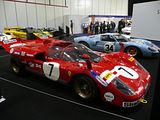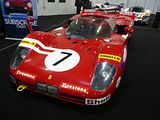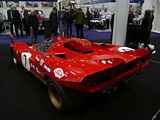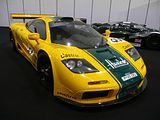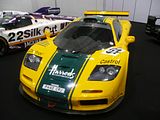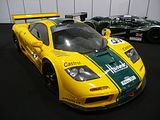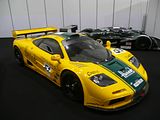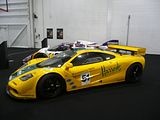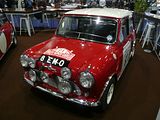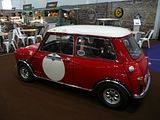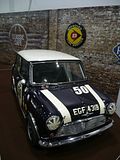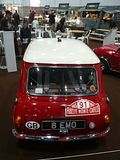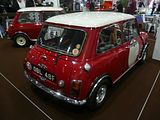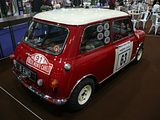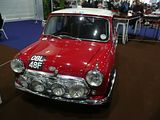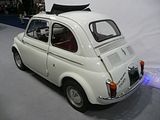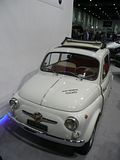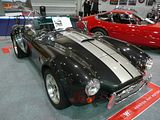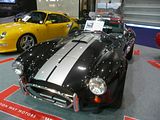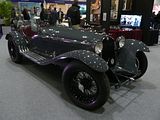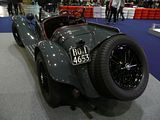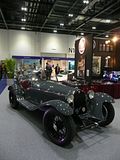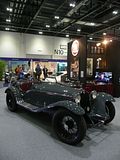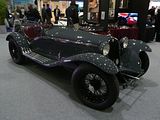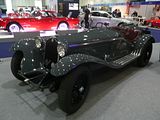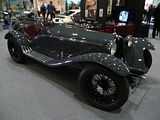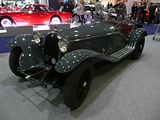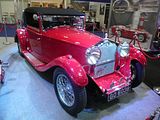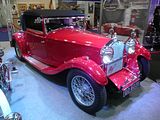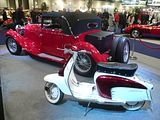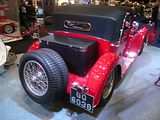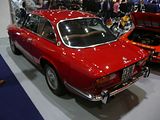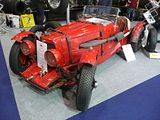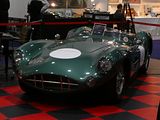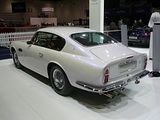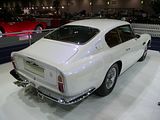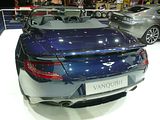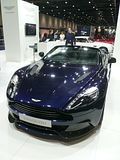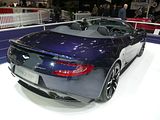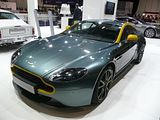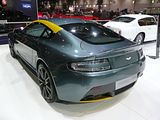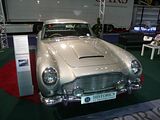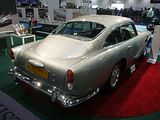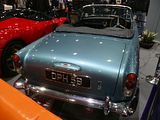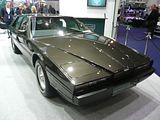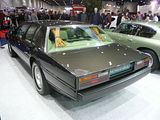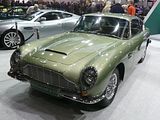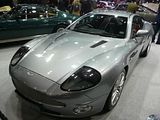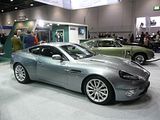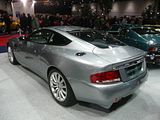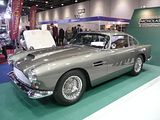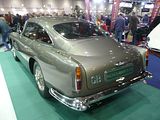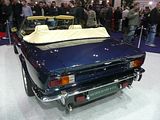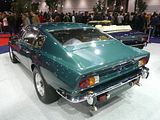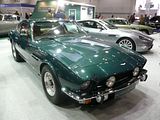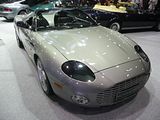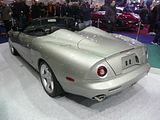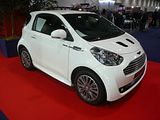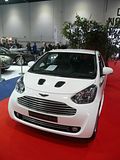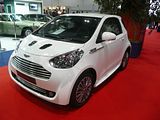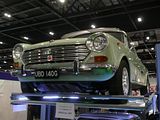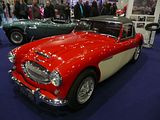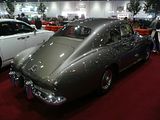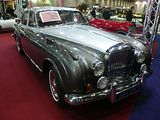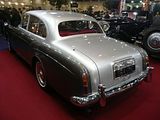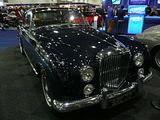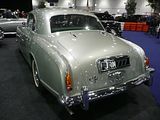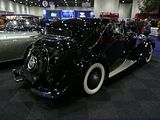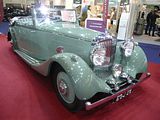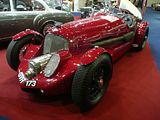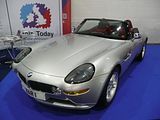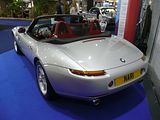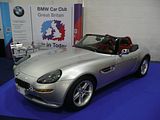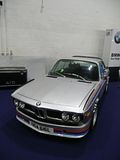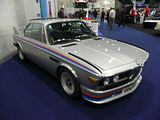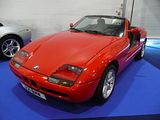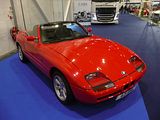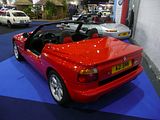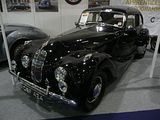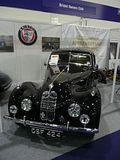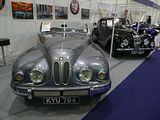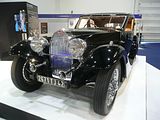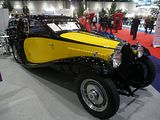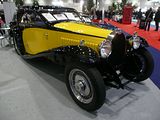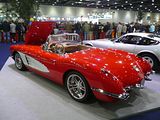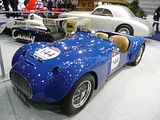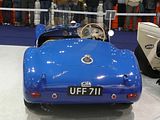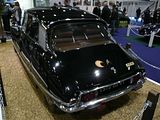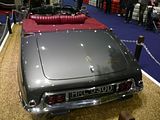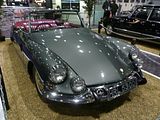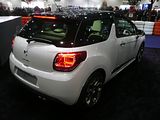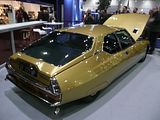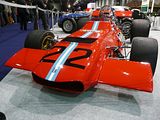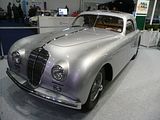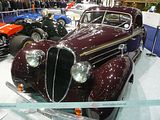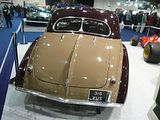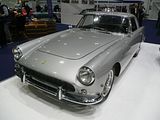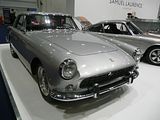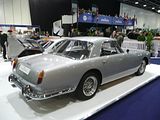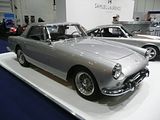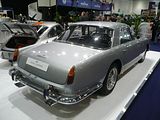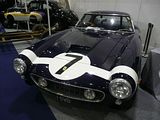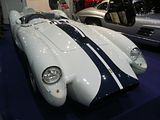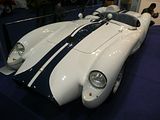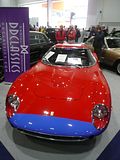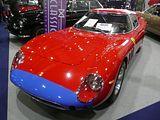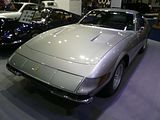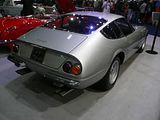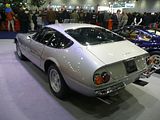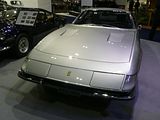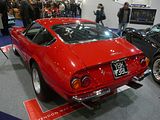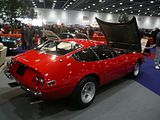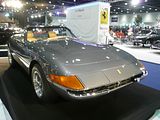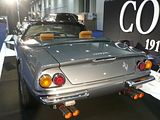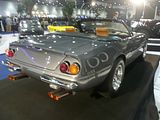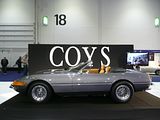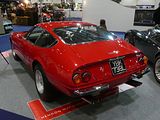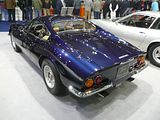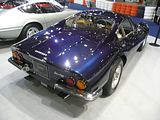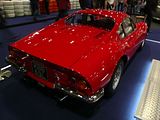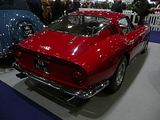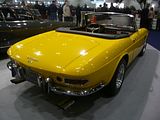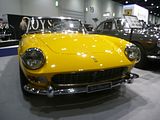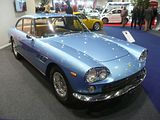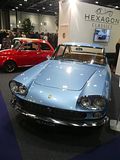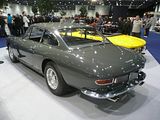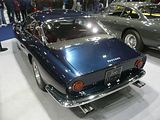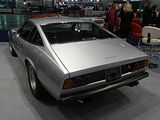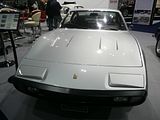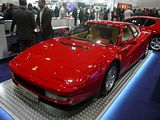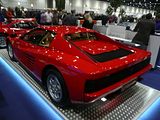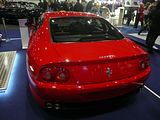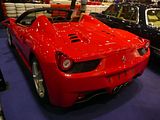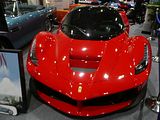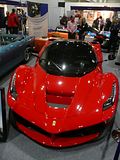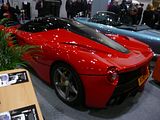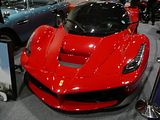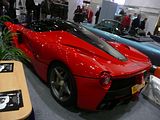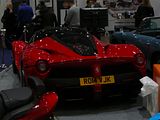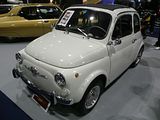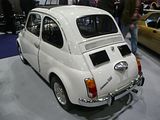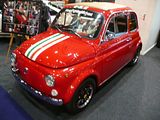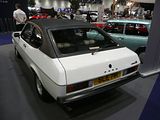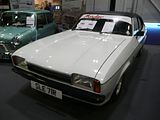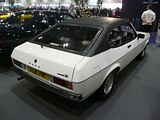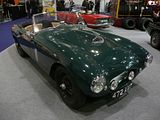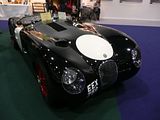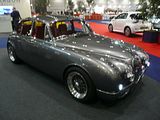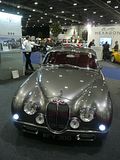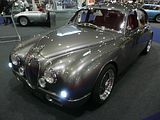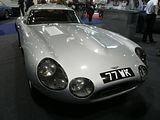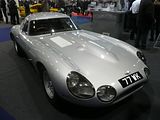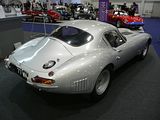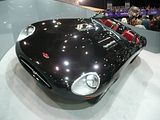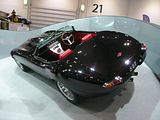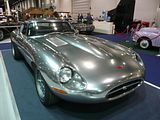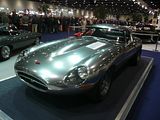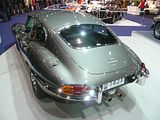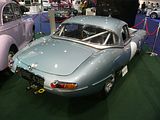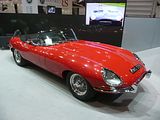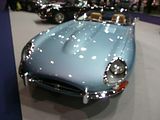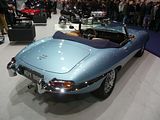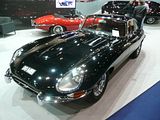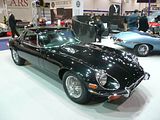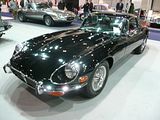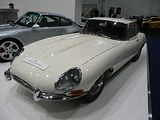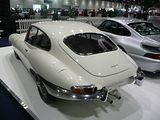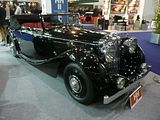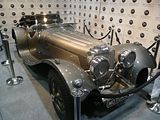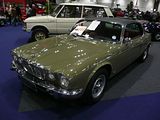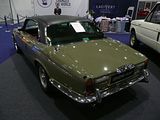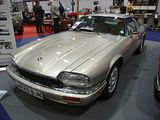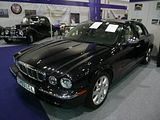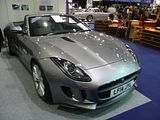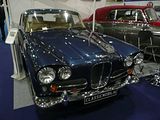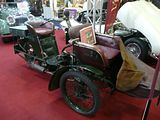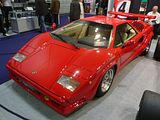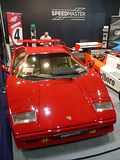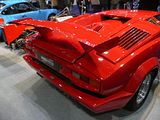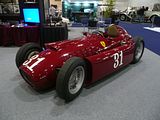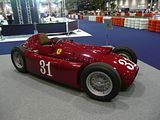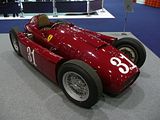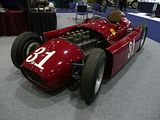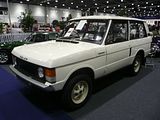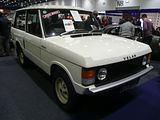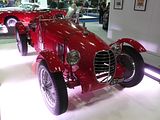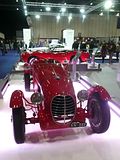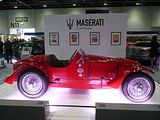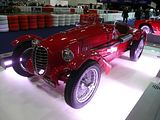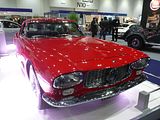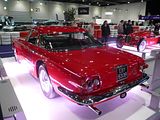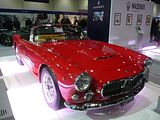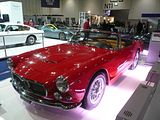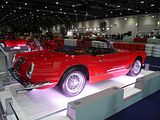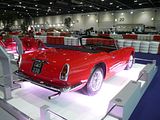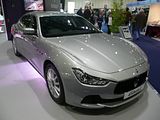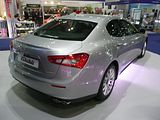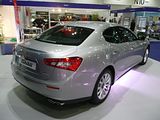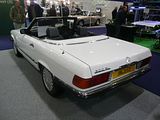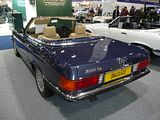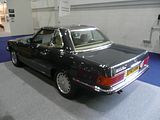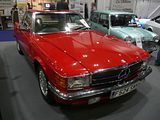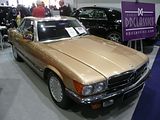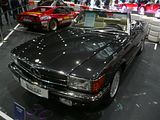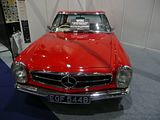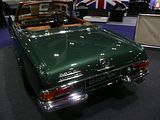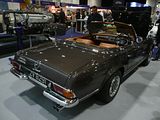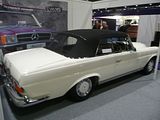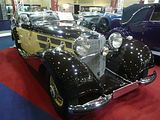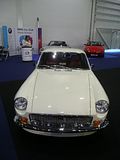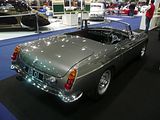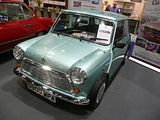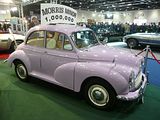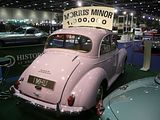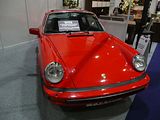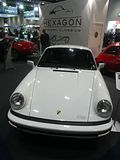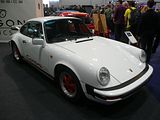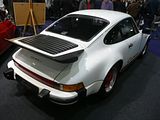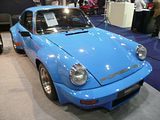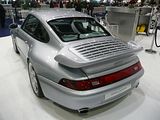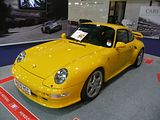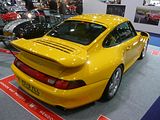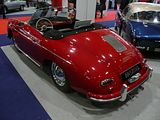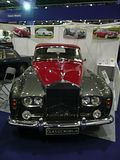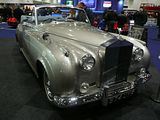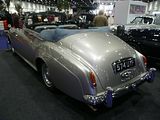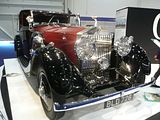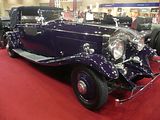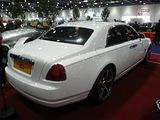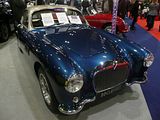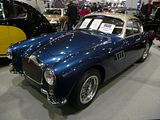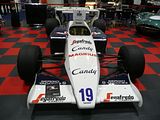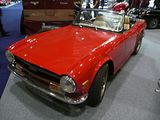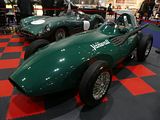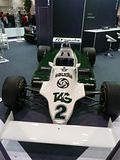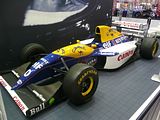During the course of a year, there are an awful lot of events for the car enthusiast, such that there are many weekends where even the toss of a coin is insufficient in helping to reach a decision on which to attend and which to forego. So is there room for yet another one? Well, careful perusal of what is on offer does reveal a few gaps. There is very little on in January, and since 2008, there’s been no significant Classic Car show in London. facts which were clearly not lost on organisers Brand Events, who decided to address both these gaps in the market with a high profile event at the London ExCel venue on the second weekend of the month. There was a lot of pre-event publicity, all of which suggested that this was going to be good, but which almost ran the risk of generating expectations that might not be realised come show opening day. The event was declared to be a rival to the long established Retromobile held in Paris and Techno Classica in Essen, which is a pretty lofty target to aim for. The early indications were good, though, with a number of special displays promised, including one to be curated by James May entitled “Cars that Changed the World”, a combination of cars and food from renowned chef and tv personality James Martin, a tribute to the cars of Adrian Newey, and most intriguingly, an area of the show called the Grand Avenue, where cars would be seen in action throughout the day. With leading names such as Duncan Hamilton, Don Law Racing, Hall and Hall, JD Classics, Jim Stokes, Nicholas Mee, J.M.E Healeys, Eagle E-types and Hexagon Classics all backing the event, by signing up to the show to present and sell their collections of notable cars, it was evident that there would be plenty of interesting, rare and exclusive cars on show, aided by a number of major manufacturers with a rich heritage, such as Maserati, Citroen and Aston Martin who also committed to help deliver something special for the inaugural event. I spent the whole day there, and found plenty to enjoy, as close on 500 photos in this report will evidence.
OUTSIDE THE SHOW
The Show was held in some of he North Halls, whilst the Boat Show was occupying the South Halls. Access to both comes from a central concours which goes east-west through the entire facility. You’ll find a wide range of eateries in here, with far more choice than you get at the NEC, and there were a couple of cars which caught my eye. First up was a new Discovery Sport. Poised to go on sale within a few days, this would be the first chance for many to see one, and to get in it and have a good look. Although I had seen them at the Paris Show, JLR’s refusal to admit me onto their stand meant that I had not previously sat in one. The good looks of the outside continue inside, though the quality of materials is not quite as premium as you might expect. The 7 seats are clever, though as with all such rear-most seats, they are really aimed more at children than adults. I have little doubt that this car will sell well, and deservedly so, too.
Placed right by the main entrance was this Ferrari.
THE GRAND AVENUE
Centrepiece of the event, and something to make it quite different from any other Classic Car show that I have attended, was The Grand Avenue. The idea was that a number of times during the day, a specially selected collection of cars would be fired up, and they would parade up and down the Avenue a number of times, giving attendees the chance to see the cars in action and to hear their distinctive sounds. During the rest of the day, the Avenue was open for public access, so you could inspect the cars at close quarters. I was unsure how this concept would work, but in practice it was excellent. It did also draw just about everyone to the centre of the venue, which meant that getting photographers of the static cars on the display stands was a whole lot easier.
40 cars were selected for this display and moving feast, with representatives from each decade of motoring. As a static display, this would have been impressive, but seeing the vehicles in motion, and hearing some of them, especially the louder ones, was a real treat.
1900s
1902 Curved Dash Oldsmobile
1910s
1912 Rolls-Royce Silver Ghost
This 1914 DFP is effectively the first production Bentley
1920s
1924 Bugatti Type 35B
1930s
1931 Bentley 8-litre
1934 Jaguar SS1

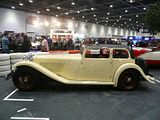
1935 Morris 8 Military Wireless car
1940s
1947 Delahaye 135M Cabriolet
1950s
1952 Alfa Romeo 6C 2500 Sport PininFarina
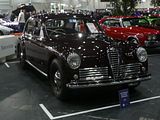

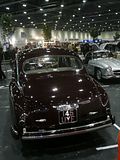
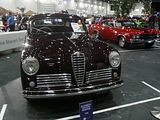
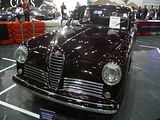
1957 Jaguar C-type (ex- Juan Manuel Fangio)
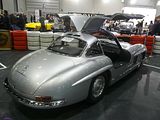
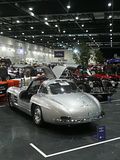
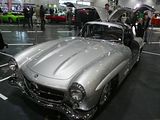
1957 Oldsmobile Starfire Convertible
1960s
1961 Citroen ID19
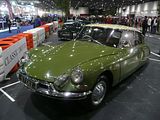
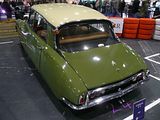
1961 Ferrari GT250 (ex-James Coburn)
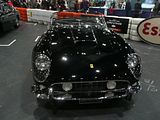
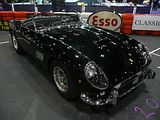
1962 Ford Cortina Saxon (undepicted)
1963 Lamborghini Muira

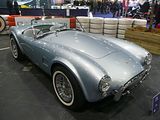
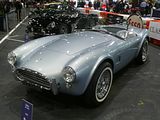
This 1965 Aston Martin DB6 was once owned by Paul McCartney. Now restored by Aston Martin Works, it sports the record player specified by him when he ordered the car 50 years ago
1969 Chevrolet Chevelle SS
1970s
1970 Range Rover (pre-production)
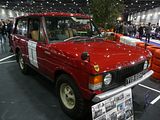

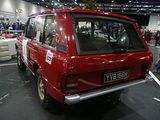
1975 Vauxhall Firenza Droopsnoot
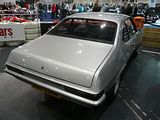
1975 Jensen Interceptor Convertible
1978 Maserati Khamsin
This 1976 Lancia Stratos Group 4 has had quite some career. Initially built as a standard narrow-bodied car, it was rallied by Ezio Facchinello, taking part in the first re-run of the Mille Miglia in 1977. In 1978 it was rebuilt to Group 4 specification, and came second in the 1979 Rally della Prealpi Vento. Following further successes in the 1980 season, it was brought to the UK and reworked for Ian Giles to race in the Intermarque Championship. It has since been completely restored and prepared for Group 4 competition use again.
1980s
1983 Audi Sport quattro
1990s
1992 Jaguar XJ220
1992 Lamborghini Diablo
Motorsport icons
The Maserati 250F started life in in 1954 and soon became the racing car of choice for all gentleman drivers. Stirling Moss and Juan Manuel Fangio both raced at the wheel, but only the Fangio won the World Championship in 1954 and 1957. The most famous of the two being Nurburgring in 1957, where it broke the lap record 10 times. Stirling Moss won the 1956 Grand Prix in Monaco, and described the car as “The finest front-engined formula 1 car you could ever drive”.
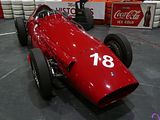
This 1964 BRM P261 is the car in which Jackie Stewart won the Italian and Monaco Grand Prix
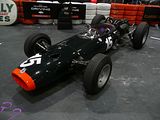
1976 McLaren M23 (ex-James Hunt)
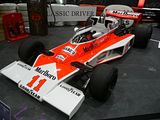

1981 JPS Lotus 87 (ex-Elio de Angelis)
CARS THAT CHANGED THE WORLD
This was the part of the show which had been trailered the most and gathered most comment. “Bold, controversial and bound to cause arguments” were phrases that appeared in the pre-event press releases and emails, and that, of course, is just the way that BBC Top Gear’s James May, who planned this exhibit, wanted it to be. May stuck his neck on the line and chose what he regards are the 13 most influential cars of all time. The result was The Cars That Changed The World, presented in a way so that you could not see the whole exhibition in one glance, as you moved around partitions and corners to discover something else that May had chosen to include. True to form, May was convinced he’d got them right… but did say that he rather hoped that others would disagree and that his choices would cause arguments in every pub in the land. He split the Baker’s Dozen into two groups of six, the first half dozen being displayed in what May calls ‘The Halls of Obviousness’ with the second half dozen found in ‘The Chambers of Bloody-mindedness’. The 13th – the most significant car ever made – had its own special display area. “You could probably guess the identity of the six in the Hall of Obviousness without reading another word,” said May, “but the other six are less well known. I believe they are just as significant historically but they’ve simply been forgotten or misunderstood. “But the 13th is certainly the car that looms largest in my motoring life – the biggest inspiration.”
The six ‘obvious’ cars (plus James’ comments) are:
1886 Benz Motorwagen. “People will argue about this, but the Benz Motorwagen was the first true car as we would understand it.”
1908 Ford Model T. “The brilliance of the Model T is the way that it was made, rather than the car itself.”
1938 Volkswagen Beetle. “It became the world’s best selling single-platform car, even though the early models were pretty horrendous to drive.”
1959 Austin Mini. “An original Mini is incredibly uncomfortable and a bit hairy if you crash it, but also fantastic to drive.”
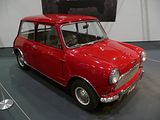
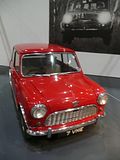

1964 Ford Mustang. “In the first six months of its life it was the fastest selling car in history. It’s the car that democratised style and performance.”
1997 Toyota Prius. “It was the first mainstream car of my lifetime that caused people to rethink the basics of how a car should work.”
And the six Bloody-minded choices are:
1901 Waverley Electric. “At the beginning of the 20th century, electric cars outsold petrol-powered cars in parts of America. They were clean, quiet and didn’t make ladies’ skirts grubby.”
1906 Cadillac Model K. “The real hero of the mass-produced car story isn’t Ford’s Model T but the Cadillac Model K.”. It is true that it was Ford who really ramped up the production volumes to previously unheard of levels, but what Cadillac achieved with the Model K was to transform what had been handbuilt cars, which often owed more to blacksmith type techniques to one where standard parts would fit each and every car.
1933 Standard Superior. “It is widely accepted that Josef Ganz, a respected Jewish engineer, came up with the basic layout and philosophy of the Beetle.” I’ll confess that I’d never even heard of this. The plaque along side the chassis revealed that Ganz was somewhat contemptuous of other automobile designs in the 1920s and he started to research what could be done to try to deliver effective transportation at a far more affordable price. By the early 1930s, he had experimented with all sorts of designs, and was producing a small car using a tubular chassis construction, independent suspension and streamlined bodywork. It attracted the interest of one Adolf Hitler, who was impressed with the car, but not with Ganz, as he was Jewish. Accordingly. Hitler approached Ferdinand Porsche and asked him to adapt Ganz’ design to produce a car for the people. a “Volks Wagen”. The rest, as they say, is history.
1972 Honda Civic. “The original Civic was a compact, lively and fuel efficient car that was well made and almost faultlessly reliable.”
1980 Lada Riva. “The Russian-built, Fiat 124-derived, Riva did more than any other to put communism on wheels.”
2009 Bruno ExoMars Rover. “Autonomous, self-sustaining and suitable for use on other planets, it is surely the world’s most advanced all-terrain vehicle.”
And the 13th?
By his own admission, this was a very personal choice. There were lots of quotes from well known motoring enthusiasts lining the walls of the chamber before you got to the display, which must have set anyone who did not know what it was really thinking (I had seen the publicity from when the show opened, so I confess I did know before getting to the chamber what it was)
And when you got there, it wasn’t a Beetle or a Mini, a Rolls-Royce or even a Ford Model T. It was, a toy… the famous Corgi model of the James Bond Aston Martin, complete with ejector seat. In justifying his choice, May said: “The thing about the Corgi DB5 is that it was a great toy at the time. If you’ve got an iPod now you’ll probably think it’s rubbish, but at the time it was absolutely amazing. Of course it is a personal and emotive choice and a lot of people will disagree with me. But that’s the point of this display. It’s about starting a debate rather than concluding one.” The car was certainly popular in its day. In the wake of the classic Goldfinger film, starring Sean Connery as the suave British agent, James Bond, Corgi produced a gold Aston Martin DB5 to 1:46 scale model complete with retractable machine guns, opening roof with ejector seat, rear bullet screen and telescopic riders. May wasn’t the only one who caught the Bond bug, the little gold Aston went on to become the biggest selling toy of 1964 selling in excess of 6,000,000 units, and received the first ever ‘Toy of the Year’ award. Though 50 years has passed, May’s choice is very topical as Corgi will be unveiling a new and fully featured re-issue of the original DB5 at the annual London Toy Fair later this month.
ADRIAN NEWEY’S CARS
Another of the special themed displays, in one of the other corners of the venue was around the various cars associated with the most successful designer in Formula 1, with no fewer than 10 world titles to his name, Adrian Newey, both professionally and in his personal life. Charting a career that began when, aged 10, he started making plastic models of Grand Prix cars – his first was a 1:12 scale Lotus 49B – and really took hold a couple of years later, this was a fascinating display, carefully planned so that even the man in whose honour it was set up had a surprise, as the organisers had managed to track down a yellow Lotus Elan Sprint once owned by his father and which he last saw in 1980. Newey apparently knew nothing of this and on the inaugural night, he was called up on stage by Chris Evans to say a few words, then right at the end he was asked what was the first car he had modified. Fortunately, he got the answer right as he was then surprised by the very car being driven into the event. This was probably the car which really cemented his life long interest in cars, when aged 12, he helped his father to build this car. What was supposed to take just a weekend to assemble actually took 10, but it was enough – he was hooked!
Among the cars that meant so much to him when he was growing up were his father’s Riley RMF – ‘a beautiful thing’ – and a Mini Cooper S, the car in which he learned to drive.
Other machines on show were from his private collection and included a Jaguar SS100 that he bought ‘as a bag of bits’ and restored. This car was then used as the template for the panels that Suffolk Cars now use for their replica SS100 models.
Also here were the Ford GT40 he races at Goodwood and other historic events, a McLaren F1 GTR, a car he calls ‘the first properly built hypercar’, and his Ferrari California.
Having won World Constructors’ Championships for Williams (five), McLaren (one) and Red Bull (four), it was no surprise to see examples of all three on the stand. The Williams era was represented by a 1992 FW14B, the car that gave him his first (and Nigel Mansell’s only) world title.
Although his Red Bull designs have dominated the sport in recent years, it’s a car that didn’t win a title that was on show, the RB5, the car that gave Sebastian Vettel his wings in 2009 with four wins and the runner-up slot in the championship.
The exhibit also featured cars from Newey’s early career including the March 86C Indy car that won the Indianapolis 500 in 1986 as well as his first ever F1 car, a Leyton House 881.
LEGENDS of LE MANS
Six significant sports racing cars from recent decades formed a fabulous display in one corner of the show, entitled “Le Mans – The Icons”. The cars – from Ferrari, Ford, Porsche, McLaren, Bentley and Jaguar – recalled some epic duels from the famous 24 Hour race. Each car on show came with a genuine Le Mans history, with winners to the fore. The youngest car on display was the Bentley Speed 8 that won the gruelling race in 2003 in the hands of drivers Rinaldo Capello, Briton Guy Smith and the most successful Le Mans driver ever, nine times winner Tom Kristensen.
The battles between Porsche and Jaguar, which dominated the 1980s, were represented by two cars in their iconic battle dress: a Rothmans Porsche 962 and a Silk Cut Jaguar XJR-9. The 962 was the successor to the ultra-successful Porsche 956 and had a long winning career throughout the 1980s despite tough opposition from rivals such as Jaguar, Mercedes-Benz, Nissan and Toyota. A Rothmans 962 driven by Derek Bell, Hans Stuck and Al Holbert won Le Mans in 1986 and 1987 with Bell claiming no fewer than 21 endurance racing wins in the 962 in total.
Porsche dominated the decade at Le Mans, until 1988 when Jaguar finally broke the German company’s stranglehold on the race. Powered by a fearsome 7-litre V12 engine, the Silk Cut sponsored car driven by Jan Lammers, Johnny Dumfries and Andy Wallace finished the 24 Hours only just ahead of a Porsche 962. Jaguar won again two years later with Martin Brundle among the driving force this time.
Two decades earlier it had been the turn of Ford to ‘own’ the great race. Piqued at not being able to buy Ferrari, then the dominant marque at the race, Henry Ford decided to build a car to beat the red racers. That car was the Ford GT40 which, after a false start, went on to claim wins in 1966, ’67, ’68 and ’69, with the last two of those wins claimed by the same GT40 (chassis number 1075) wearing the famous light blue and orange colours of Gulf .
Ford’s turn at the top marked the end of Ferrari’s reign in France, though the company did try to resurrect past glories with the 512S. It was not hugely successful but still managed to claim an important part of Le Mans history by starring in the film of the same name. After racing the car in the 24 Hours in 1970, Derek Bell was hired to drive the same car for the Steve McQueen movie, but the car was burnt out during the filming. Pink Floyd drummer and classic car collector Nick Mason rebuilt it, however, and it is this very car that was on display here.
The final Le Mans legend was another hugely significant car, the BMW-powered McLaren F1 that, 20 years ago in 1995, became the last road legal car to win the great race. The car on show is the ‘Harrods’ car – sponsored by the famous London store – that finished third in ’95, driven by Andy Wallace and father and son Derek and Justin Bell.
JAMES MARTIN’s CARS
Renowned tv chef James Martin had a display area which combined his two passions: cars and food. Backdrop to this section of the event were a couple of historic vans from which “affordable” food was being served, which he had created, and then in among the seating area for his patrons were 5 classic Minis from his collection. Martin maintains a soft sport for Issigonis’ masterpiece, as this is the car that he grew up driving. More recently he has been able to purchase some historically significant versions of the little car, including the ‘works’ Cooper S that the legendary Paddy Hopkirk rallied back in 1963.
DISPLAY CARS
The rest of the event comprised an array of stands, many of which were dealers, included those listed above, as well as some manufacturer representation. There were a few Car Clubs, but not many. I understand that the number of these will likely be expanded next year. Whilst the prices of many of the cars that were offered for sale were way beyond my budget, it was nice to look.
ABARTH
This is an early example of the Nuova 500-based 595 Abarth, as evidenced by the rear hinged doors. Needless to say, as an original car rather than a recreation, the price tag was ambitious.
AC
This 5 litre Mark IV Cobra dates from 1997.
ALFA ROMEO
I know I am biased in favour of this marque, but truly. there were some splendid Alfas at the show. Absolute favourite, and by some measure the most valuable was this 1933 8C2300. The 8 cylinder models are a lot less common than the 6 cylinder cars, and they’re worth even more, so it was a real joy to see this one, a car which has had a somewhat chequered past. around the world.
There was a 6C 1750 as well, but instead of the Touring and Zagato bodies which are the ones you most often see, this was a saloon version. It was utterly splendid.
Far better known, of course, are the 105 Series of the 1960s and 1970s and this was a lovely 2000GTV, still on Italian plates.
ASTON MARTIN
This is thought to be the most original, and certainly unrestored, Ulster from 1935.
The Aston Martin DBR1 was a sports racing car built by Aston Martin starting in 1956, intended for the World Sportscar Championship as well as non-championship sportscar races at the time. It is most famous as the victor of the 1959 24 Hours of Le Mans, Aston Martin’s only outright victory at the endurance classic. Following changes to the rules for sportscar racing, entrants no longer had to use cars which were road legal, or based on road legal cars, such as the Aston Martin DB3S. Therefore, with the ability to create a sportscar from a clean slate for 1956, Aston Martin created the DBR1, with Ted Cutting as chief designer. The body evolved from the DB3S’s shape, featuring a much lower profile. Most notable was that the back of the front wheel well was no longer left open. Instead, the DBR1 featured full bodywork with a large triangular vent on the side, a design trait which would become standard on all future Aston Martins. The DBR1 was initially fitted with a smaller 2493 cc new all alloy racing engine very loosely derived from the racing version of the Lagonda Straight-6 engine, even though the DBR1’s predecessor, the DB3S, was at the time racing with a larger 2922 cc engine. Later DBR1s would feature the RB6.300 Straight-6 rated at 250 hp.
This 1970 Series 2 DB6 Vantage has just emerged from a very comprehensive restoration and modernisation, costing several hundreds of thousands. The stand staff said that it is now offered for sale at a cool £750k. For that you get a lovely looking car with sone subtle updates such as automated climate control and a modern pearlescent paint finish, as well as all the good bits about this classic model. Still, that is a lot of money, though.
There were three new Astons on the same stand: a Vanquish Volante, a Rapide S and the slightly brash looking N430 version of the V8 Vantage.
Elsewhere there was a nice DB5 model.
To my mind even more covetable was this, a Series 5 DB4 Convertible, one of just 14 such RHD cars built.
Nicholas Mee, a well known Aston specialist dealer had a really mouth watering array of cars on their stand. Most striking of these was an example of the Williams Towns styled Lagonda. The undisputed star of the 1976 Earls Court Motor Show, this futuristic car took a number of years to get into production, and when they did, the first car memorably broke down, thanks to complex electronics which were somewhat ahead of their time, on the day of delivery.
Other cars included a DB6 Series 2, Vanquish and DB4, one of just 22 of the “Prince of Wales spec” V8 Vantage Volantes and Vantage
Rarest of all though was this, an AR1. Just 99 of these Zagato styled Roadsters were made, and none were officially sold here, hence the lack of roof.
Parked in the corridor near this stand was one of the ill-fated Cygnets. I was intrigued to read a comment in respected motoring journalist, Steve Cropley’s weekly column in Autocar, where he postulates that in years to come, these cars could be collectible. Maybe they will. Only 400 were made, and there was nothing particularly wrong with the car apart from the overly ambitious price.
AUSTIN
Never sold in this guise in the UK, the “Ute” version of the well known ADO17 “Land Crab” was made specially for the Australian market. A handful of these have since found their way to Britain. This one was exhibited high up in the air on a stand that was selling lifts and stowage systems
AUSTIN HEALEY
There was one example of the much loved Big Healey, the 3000.
BENTLEY
The La Sarthe has now appeared at quite a few events, so I know a little bit more about what it is. A modern recreation of an earlier style, the Le Sarthe is based on an early 1950s R Type chassis, but with a modern body, which makes it what its designer calls a “Special Bentley” as opposed to a “Bentley Special”.
You could say that the La Sarthe takes its inspiration from this, the Continental Type R, and that would not be far off the mark. A high-performance version of the R-Type, it was the fastest four-seat car in production at the time, in 1952. The prototype was developed by a team of designers and engineers from Rolls-Royce and H. J. Mulliner & Co. led by Rolls-Royce’s Chief Project Engineer, Ivan Evernden. Rolls-Royce worked with H. J. Mulliner instead of their own coachbuilding subsidiary Park Ward because the former had developed a lightweight body construction system using metal throughout instead of the traditional ash-framed bodies.The styling, finalised by Stanley Watts of H. J. Mulliner, was influenced by aerodynamic testing conducted at Rolls-Royce’s wind tunnel by Evernden’s assistant, Milford Read. The rear fins stabilised the car at speed and made it resistant to changes in direction due to crosswinds.A maximum kerb weight of 34 long hundredweight (1,700 kg) was specified to keep the tyres within a safe load limit at a top speed of 120 mph. The prototype, with chassis number 9-B-VI and registration number OLG 490, which earned it the nickname “Olga”, was on the road by August 1951. Olga and the first series of production Continentals were based on the Mark VI chassis, and used a manual mixture control on the steering wheel boss, as these versions did not have an automatic choke. The early R Type Continental has essentially the same engine as the standard R Type, but with modified carburation, induction and exhaust manifolds along with higher gear ratios. The compression ratio was raised to 7.25:1 from the standard 6.75:1, while the final gear ratio was raised (lowered numerically) from 3.41 to 3.07. Despite its name, the two-door Continental was produced principally for the domestic home market, most of the 207 cars produced were right-hand drive, with 43 left-hand drive examples produced for use abroad. The chassis was produced at the Rolls-Royce Crewe factory and shared many components with the standard R type. R-Type Continentals were delivered as rolling chassis to the coachbuilder of choice. Coachwork for most of these cars was completed by H. J. Mulliner & Co. who mainly built them in fastback coupe form. Other coachwork came from Park Ward (London) who built six, later including a drophead coupe version. Franay (Paris) built five, Graber (Wichtrach, Switzerland) built three, one of them later altered by Köng (Basel, Switzerland), and Pininfarina made one. James Young (London) built in 1954 a Sports Saloon for the owner of the company, James Barclay. They are highly prized (and priced!) these days.
In 1955, the S Type replaced the R Type in the Bentley range, and once again, many of these cars were dispatched to the coachbuilders for the body of choice to be built on the standard chassis. A number of S Type models were shown here, including some of the Continental models.
By the time the T Type had replaced the S, there were no significant differences between Rolls Royce and Bentley save the grille and badging. The former achieved almost all the sales, meaning that Bentley badged cars of this era are very rare. This is a very splendid Continental Convertible, a close relative of the Corniche of the era. It is a Series IV car with the body coloured bumpers.
Following the acquisition of Bentley by Rolls Royce, the company was taken in an entirely new direction with the creation of the “Silent Sports Car” or Derby Bentley. In 1933 the new Bentley 3 ½ Litre model was released and was an instant success. The combination of effortless power and style met with almost universal praise. It was powered by a developed twin carburettor version of Rolls-Royces own 20/25 model and was installed in a low 126 inch wheelbase chassis that basically remained unaltered until the cessation of production in 1939 due to the outbreak of hostilities. Synchromesh was present on third and fourth gears and the Derby’s were fitted with a cross flow cylinder head and superb servo assisted brakes, encapsulating all of the perfection of Rolls-Royce engineering in this small sporting Bentley. 1936 saw further improvements with the introduction of the 4 ¼ Litre model when production of the 3 ½ Litre unit ceased. Steady development continued throughout the cars production and in late 1938 even more power was obtained when the overdrive models were introduced, which were known as the MX/MR series cars. The original Bentley sales literature outlined the key improvements that improved the overdrive cars performance which included the provision of an overdrive gearbox which would allow the car to attain a greater maximum speed without exceeding maximum engine revolutions. The steering was of improved design, providing greater control under all conditions. Modified gear ratios and slight engine modifications also improved acceleration under certain conditions. The slower running engine coupled with the over drive top gear resulted in greater silence and smoothness. And finally centralised chassis lubrication and automatic shock absorbers with over-riding hand control were fitted. The MX/MR models were truly the ultimate incarnation on the Derby chassis and are still very much sought after some seventy years on. Just two hundred chassis examples were created, finding their way to lucky owners with a variety of coachwork designs. This is one of just two sedanca coupes built by Hooper on the Derby Bentley chassis, this particular car being built to Design No 7683. This unique and flamboyant motor car was originally ordered by Lady Duff Ashton-Smith who belonged to one of England’s wealthiest families. The car still retains the original coach lamps engraved with her monogram. The car was completed in 1939 but because of the onset of the war she never took delivery. It was eventually delivered in November of 1940 to its first owner, Mr Basil M. Mavrolen who was a London based shipping magnate. In 1942 it was purchased by American diplomat A.J. Drexel-Biddle who served as a Major General in World War I before beginning his diplomatic career. Following the Second World War, the car was stored and displayed at the Musee 1900 in Provence for over fifty years, which explains the cars beautifully preserved condition and extremely low mileage; the odometer still reads less than 70,000 kilometres from new. In more recent years the car was sympathetically prepared by P&A Wood, with expenditure totalling several tens of thousands of pounds. Unsurprisingly, this beautiful motor car has several unique features, one being the “crocodile roof” mechanism. The rear portion of the roof can be raised with a coach key allowing the front section of metal roof to detach and slide backwards, being stowed seamlessly once the rear portion of the roof is lowered again. We believe this to be the only Derby Bentley to feature this style of sedanca roof arrangement, which was used more commonly by Hooper on cars built in the post war era.
Fitting of individual coachwork by approved body builders means that there are all manner of different looking Derby Bentleys. One of the most popular coachbuilder was Park Ward, whose body features on this car.
Petersen Racing make very small of numbers of bespoke cars, built to order. This one was first registered in 1991, based on a 1953 Mark VI chassis. It sports a 6.6 litre supercharged engine.
BMW
Three classic BMWs displayed on the BMW Car Club’s stand were the Z1, Z8 and 3.0 CSL
BRISTOL
There were two early Bristols on the Owners Club stand, a 400 and a 402 Drophead
BRM
This 1960 BRM P48, chassis No. 2, has a 2.5 litre 4 cylinder and was driven by Graham Hill and Dan Gurney.
BUGATTI
Type 57 Bugatti were made between 1934 and 1940. At the heart of the car was the jewel-like straight-eight, twin-cam 3.3 Litre, (a descendant of the world-beating Type 51 Grand Prix racing cars’ powerplant) which like all Bugatti engines is as beautiful as it is functional. With 710 models produced, the Type 57 was to become the best-selling Bugatti of all in various increasingly sophisticated forms until 1939 when the Second World War intervened. The production run coincided with an exceptionally graceful era of coachwork design, with many of the Type 57s being among the most elegant of all Bugatti models produced. This Ventoux model is an uncommonly pure example of the superb early version of the design, with ‘profilee’ windscreen and what were known as ‘spats’, filling in the rear wheel arches, and the frontal aspect is balanced by a small integral projecting luggage boot. It is most handsomely finished in Embassy Black, and of course retains the correct wire wheels. The interior is the epitome of restrained good taste, luxuriously finished in Tan leather with matching carpets, and the typically Bugatti elegant polished wood dashboard carries the correct Jaeger ‘art deco style’ instrumentation cluster and authentic switchgear. World renowned Bugatti specialist David Sewell has confirmed that this particular Ventoux, chassis number 57196 and was produced in early July 1934 and three months later was fitted with factory built coachwork which was completed on 2nd October ’34. It was then invoiced on the very same day for delivery to Messrs Crequey & Cornette of 59, Rue d’Artois, Lille who were Bugatti agents for the north of France and invoiced 63,744 francs for their client named de Leseleuc. Hugh Conway’s Bugatti Register update in 1973 confirms the car was on display at the Bonnal Museum in Bordeaux and later in 1985 Pierre-Yves Laugier confirms in his French Bugatti register that it is owned by a French collector, A Prost of Roanne, some 50 miles north west of Lyon who is believed to be a member of the same family as Grand Prix driver Alain.
Also shown was an earlier 1930 Type 46 Superprofilée. First shown at the 1929 Paris Motor Show, the Type 46 was positioned in the range between the Type 44 and the massive Royale. As was the case at the time, various body styles were offered, of which this one, with its very steeply raked windscreen was the most striking.
CHEVROLET
The wheels on this 1959 Mark 1 Corvette are utterly ghastly and do their best to ruin what was otherwise a nicely turned out example of the first generation of Chevrolet’s long lived and much loved sports car.
CISITALIA
This 1948 Cisitalia 202S MM was driven by Dusio in the 1948 Mille Miglia. Taken to Argentina by Dusio, it then won the Argentinian 1500cc sports car championship for three years in the hands of Ernest Tomquist, after which, in 1951, it was fitted with a 1.4 litre Gordini engine which it retains today. It was brought back to the UK 20 years ago, and competed in the Coppa d’Italia, but has not been seen much since then. It is now offered for sale.
CITROEN
To some it is the most beautiful car of all time, a ‘Goddess.’ To others, it was the most technically advanced car of its era, a revolutionary machine that was years ahead of its time. 2015 marks the 60th anniversary of the birth of the Citroën DS, a car which still has the ability to turn heads like few other classic cars. The DS (pronounced Déesse, the French word for Goddess) was launched at the 1955 Paris Motor Show where its avant-garde design stunned show goers. Some 743 orders were taken in the first 15 minutes of the show opening and by the end of the first day that total had risen to an incredible 12,000. At a time when most cars were rear-wheel drive and running on old-fashioned ‘cart springs’, the DS19’s futuristic specification featured front-wheel drive, hydropneumatic self levelling suspension, a semi-automatic gearbox and even a fibreglass roof to lower the centre of gravity. To celebrate the diamond anniversary of the car that, according to French philosopher Roland Barthes, looked as if it had ‘fallen to earth’, the DS will be enjoying several significant birthday parties during 2015. Even before the French do something special at Rétromobile, which they surely will, the first of those celebrations was right here, with a stand which had a number of examples of both the DS and its sibling the ID (pronounced Idée, French for Idea). It was particularly nice to find that this display included an example of the highly collectable convertible or décapotable. Several of these have been created in more recent times, as prices for the genuine article have rocketed well into six figures, but this is an official 1966 car.
And bringing the story right up to date, this event marked the UK debut of the new, stand-alone DS brand. The separation of Citroën and DS was announced on 1 June 2014 and the two marques were exhibited side by side as two distinct brands for the first time in Europe at the Paris Motor Show in October. The aim of DS is to return the French automotive industry to the ranks of the premium carmakers, which could mean some future classics along the way. They may need some new products for that. Shown here were the familiar DS3 and DS5.
The SM combines a growling Maserati V6 engine, with the sophisticated Citroën suspension in an attempt to become the epitome of what a Gran Turismo car could be. Launched at the 1970 Geneva Show, it was the fastest front-wheel drive of its time competing with the likes of Jaguar, Lotus, Porsche and Aston Martin and was an example of how progressive technology could be. Garish and gold this Citroën SM stood proud on the Ludovic Parayre stand as part of his Lap63 display. People have feared the complexity of these cars for years, but now confidence is increasing as are the prices, and you would need in excess of £40,000 to secure this one.
DE TOMASO
This DFV powered Formula 1 car, a de Tomaso 505 was a successful design by Dallara which was driven by Piers Courage in 1970.
DELAHAYE
Dating from 1947 is this 135 MS Coupe with one off coachwork by Farina. This the only example of the marque ever bodied by Farina and is a stylish design with transparent roof panel. The car has a 3.6 litre engine with triple Solex carburettors and Cotal gearbox.
There was a second 135 model, also on the Hall & Hall stand.
FERRARI
There were lots of Ferrari models scattered throughout the show, as you might expect. Most of them were on dealer stands, among them were Joe Macari, Duncan Hamilton, JD Classics and Hexagon Classics.
This 250GT was absolutely stunning. During the 1950s, Ferrari had been producing small numbers of cars, with bodies supplied by a number of Italian coachbuilders. The 250 GT was the result of Ferrari’s desire to enter series production in order to stabilise the company’s finances, Pininfarina was asked to design a simple and classic car, and the result was introduced at Milan in 1958. The GT Coupe eschewed the fender vents for simple and clean lines and a notchback look with a panoramic rear window. The oval grille was replaced by a more traditional long narrow look with protruding headlights. Telescopic shock absorbers were also fitted instead of the Houdailles found on previous 250s, and disc brakes were added in 1960. After constructing the earlier 250 GT Boano/Ellena models, Pininfarina’s Grugliasco plant had been expanded and there was ample capacity for the production of this new coupe, such that 335 nearly identical examples had been built by 1960. Buyers included Prince Bertil of Sweden.
Tucked away at the back of the venue was this 250 GT SWB. One of the better known early Ferraris, examples of this model are to be seen at historic motor racing events as well as concours. First seen in 1959, the 250 GT Berlinetta SWB used a short 2,400 mm (94.5 in) wheelbase for better handling. Of the 176 examples built, both steel and aluminium bodies were used in various road (“lusso”) and racing trims. Engine output ranged from 237 bhp to 276 bhp. Development of the 250 GT SWB Berlinetta was handled by Giotto Bizzarrini, Carlo Chiti, and young Mauro Forghieri, the same team that later produced the 250 GTO. Disc brakes were a first in a Ferrari GT, and the combination of low weight, high power, and well-sorted suspension made it a competitive offering. It was unveiled at the Paris Motor Show in October 1959 and quickly began selling and racing. The SWB Berlinetta claimed GT class of the Constructor’s Championship for Ferrari in 1961. These cars are highly prized nowadays and for good reason.
This is an example of the first car to bear the Testarossa name, adopted because of the red colour of the valve covers. 34 of these racers were built between 1956 and 1961.
Originally delivered new in Italy in 1963 as a 250 GTE, chassis number 4769. In the 80s, the car was bought by prominent Ferrari collector Glen Kalil of Palm City, Florida. In the 80s, Kalil commissioned Mario Allegretti to hand make an exact copy of the famous 250 GTO, chassis # 3445 GT which in 1965 was rebodied by Piero Drogo and the exquisite lines of this beautiful craftsmanship are the inspiration for 4769 GT. Significant chassis modifications were carried out and it is understood the body was built to the original drawings, body bucks and by the same panel beater that created the original Drogo Speciale. The car was exactly as the original, with sliding side windows and an identical bodyline, round side markers and no bumpers. 4769 was later sold to prominent collector Roger Willbanks of Denver Colorado in the early 90s, who used it on events such as the Colorado Grand for many years. Although Allegretti’s was of the highest possible standard, 4769 was known to have a slightly cramped driving position, which has recently been rectified so that today, the car can now be driven comfortably by 6ft + drivers. Very recently the car has had its dry Sump 6 Webber 250 V12 freshly rebuilt by Ross Coleman, formerly the shop foreman for Wayne Obrey’s Motion Products. 4769 is also fitted with a gated, 5-speed, GTO style finned gearbox and a high quality newly re-upholstered interior
I’ve been a huge fan of the 365 GTB/4 “Daytona” since childhood, when this car, with its quoted top speed of 174 mph from its V12 engine was a winner in Top Trumps. You don’t see them that often, so to come across 4 of the Coupe models and one of the 365 GTS Spider cars was quite a treat. Among them was a rare plexiglass fronted car, which is how Ferrari intended the model to be, but which was soon abandoned in favour of the pop up headlights. Launched at the 1968 Paris Show, the car was produced for 5 years. The generally accepted total number of Daytonas from the Ferrari club historians is 1,406 over the life of the model. This figure includes 158 right-hand-drive coupés, 122 factory-made spyders (of which 7 are right hand drive), and 15 competition cars in three series with modified lightweight bodies and in various degrees of engine tune. All bodies except the first Pininfarina prototype were produced by Scaglietti.
Dating from the same era, and probably even prettier to look at was the 246 GT Dino and there were a couple of these gems on show. Prices for these have rocketed in the last couple of years, taking them into the super-collectible bracket.
That’s a place the 275 GTB has occupied for many years, with these cars all fetching over £1 million when they come up for sale. The model marked its 50th anniversary last year and it was pleasing to see quite so many of them out and about at events.
The open topped version of that car was called 275 GTS, and although it shares the mechanicals with the GTB, the body styling is different. I think this is a lovely looking car.
Those who craved four seats in their Ferrari were not ignored, with the 330GT 2+2. First shown at the Brussels Show in January 1964, this was much more than a re-engined 250, with a sharper nose and tail, quad headlights, and a wide grille. The wheelbase was 50 mm (2.0 in) longer, but Koni adjustable shock absorbers improved handling. A dual-circuit Dunlop braking system was used with discs all around, though it separated brakes front to back rather than diagonally as on modern systems. When leaving the factory the 330 GT originally fitted Pirelli Cinturato 205VR15 tyres (CN72). The 1965 Series II version featured a five-speed gearbox instead of the overdrive four-speed of the prior year. Other changes included the switch back to a dual-light instead of quad-light front clip, alloy wheels, and the addition of optional air conditioning and power steering. Prior to the introduction of the ‘Series II’ 330 GTs, a series of 125 ‘interim’ cars were produced, with the quad-headlight external configuration of the Series I cars, but with the five-speed transmission and ‘suspended’ foot pedals of the ‘Series II’ cars. 625 Series I (including 125 ‘interim’ cars) and 455 Series II 330 GT 2+2 cars had been built when the car was replaced by the 365 GT 2+2 in 1967.
Predecessor to that had been the 250 GT Lusso, sometimes referred to as the 250 GT/L. Introduced at the 1962 Paris show, the car sported flowing lines and a fastback shape typical of the GT cars of the mid-1960s. Under the bonnet was the 250 GTO’s Tipo 168 engine with 240 bhp and three Weber 36DCS carburettors. Scaglietti handled construction of the Lusso which was made through to 1964 with few modifications. Rock star Eric Clapton owned one, and an example that had been owned by Steve McQueen was sold at auction for $2.3 million in August 2007.
Based on the chassis of the Daytona, but with a slightly stretched wheelbase, the 365 GTC/4 had a very different looking body. It was only built for 2 years, during which time 505 examples were made.
Object of desire, and featuring on posters of many small boys in the 1980s was the Testarossa. A replacement for the Berlinetta Boxer, the Testarossa made its debut at the 1984 Paris Show, and whilst it lacked the dramatic styling of its main rival, the Lamborghini Countach, this was still a car like no other.
Providing four seats and a Ferrari badge in the 1990s was the 456 GT, a very pretty looking car which is currently somewhat overlooked by most enthusiasts. I am sure its time will come.
From the current range was this 458 Spider, the open topped version of Ferrari’s “volume” seller (it’s a relative term!).
First of the truly special Ferrari models of recent time was the 1984 288 GTO, a car which looked from a distance like the 308 GTB, but which was very different under the skin. Just 272 were made, which is fewer than all the following hypercar models, so it was nice to find this example tucked away in one corner of the show.
A complete surprise was to come across this LaFerrari which was tucked away in one corner of the show, on a stand that was not even focused on Ferrari models at all. It was frustrating for the photographer, as it was hemmed in with rope barriers that were close to the car, and the people on the stand did keep standing in the way. I did my best!
FIAT
There were a couple of examples of the classic Nuova 500. Fiat’s irrepressibly cheeky little car that has an enthusiastic following, and which of course inspired its maker to produce the hugely successful 2007 version.
FORD
Only classic Ford at the event was a rare one, a Mark 2 Capri. This version of the “car you always promised yourself” was produced between 1974 and 1978 and is the one that tends to be ignored in favour of the Mark 1 and Mark 3 cars.
FRAZER NASH
Le Mans Replica
JAGUAR
Suffolk Engineering are well known for the quality replicas of historic Jaguar models that they produce, and they had a number of examples of the cars that they produce on their stand, including a C Type and the earlier SS100. You would have to be a real expert to be able to distinguish these from the real thing at anything other than a very close inspection.
Something a bit different was created by another name well known in Jaguar circles, CMC of Bridgnorth. This is the latest car to come from the pen of Jaguar designer Ian Callum. It’s not a new car, however, but a thoroughly modernised version of the 1960s Jaguar Mk II saloon. Callum created the car for his own use, entrusting the engineering side of the project to CMC. Although originally envisaged as a one-off, such has been the interest in the Callum Mk II – and there was lots of that at the show, so getting photos was tricky – that CMC is building a limited run of replicas and the company will be at the show taking orders.
CMC were also showing a very famous lightweight racing Jaguar E-type that took an astonishing 7,000 hours to recreate. This is the Lindner-Nocker car. Jaguar built just a dozen of the famous all aluminium Lightweight E-Types for racing. Of these, just one was modified by the Jaguar factory for owner Peter Lindner, the German Jaguar importer, to Malcolm Sayer’s Low Drag body design. It was raced by Lindner and Peter Nocker at Le Mans in 1964 before being involved, a few weeks later, in a massive accident. The car was then impounded and locked away for many years. Subsequently, the car has been recreated using all the mechanical components in a spare Lightweight tub because the mangled original body was thought to be unrepairable.
Jaguars were very much to the fore on the Eagle E-Types stand. The company had a total of nine cars at the show including two cars specially created by Eagle: the Speedster, which Jeremy Clarkson called his favourite car of all time and the Low Drag GT.
There were plenty of other E Types, of all three series.
Predecessor to the E Type were the XK range of models. Starting with the XK120 in 1948, the model evolved through XK140 to the final XK150, and there were examples of the latter two on show in the very desirable Open Two Seater and Drophead guises, respectively.
Winding the clock back to the immediate post war period, and we come to cars like this lovely Mark IV Drophead. Following an emergency wartime board meeting in March 1945, William Lyons’ SS Jaguar concern jettisoned its prefix initials and their unwanted Nazi connotations. When peace came some six months later, the newly renamed Jaguar Cars – like most British motor manufacturers – felt constrained by the government’s `export or die’ drive to put various of its pre-September 1939 models back into production (albeit with some minor improvements). Luckily for the Coventry firm, this entailed trying to sell a line-up of 1.5 litre four-cylinder and 2.5 / 3.5 litre six-cylinder cars which still enjoyed an enviable reputation for strong performance, good road manners and well appointed interiors. Top of what was retrospectively known as the MKIV range, the decidedly voluptuous 3.5 Litre Drophead Coupe boasted an ingenious three-position hood that gave occupants the choice of open, closed or coupe de ville motoring. A full five-seater, its underslung box-section chassis incorporated all-round semi-elliptic leaf-sprung suspension, lever-arm dampers, Burman worm-and-nut steering and Girling mechanical drum brakes. Credited with developing some 125bhp and 184lbft, the flagship model’s 3485cc OHV straight-six engine was allied to four-speed manual transmission and promised 95mph plus performance. Utilising the same all-steel body construction as its late 1930s SS Jaguar forebear, the newcomer appeared even more svelte thanks to a revised hypoid bevel back axle that allowed the floor to be lowered by two inches. Only spanning a seven-month period (February – September 1948), total right-hand drive MKIV 3.5 Litre Drophead Coupe production is thought to have amounted to just 184 cars – making it among the rarest of all Jaguar’s post-WW2 production models. This car has the distinction of being the very first right-hand drive MKIV 3.5 Litre Drophead Coupe built. Finished in Black with Red leather upholstery, it was completed on 17th February 1948 and despatched to the Hoffman Motor Car Co of Park Avenue, New York early the following month. A hugely influential importer of European sports and luxury cars, Max Hoffman would later convince Mercedes-Benz, BMW and Porsche to produce the 300SL `Gullwing’, 507 and 356 Speedster respectively. An unabashed aesthete who was doubtless taken with the Jaguar’s wonderfully elegant styling, he seems to have had no qualms about taking delivery of a right-hand drive car in a left-hand drive market. Although an accompanying service manual suggests that it belonged to Chas A. Mitchell of Washington DC by August 28th 1949, little else is known about the Drophead Coupe’s sojourn in America. Still retaining its original engine and coachwork when repatriated by restorer A.B. Price during 1995, the MKIV was subsequently fettled and MOT tested before being sold on. Over the years it has had a five speed gearbox and upgrade engine fitted.
Better known from this era is the SS100, the first 100mph sports car. Dating from 1938, this car has spent part of its life in Argentina.
The XJC was a short-lived Coupe version of the Series 2 XJ6 and XJ12. A very graceful design, in the best of Jaguar tradition, these cars are now admired for their elegance as well as the other XJ virtues of refinement and sophistication.
2015 marks the 40th anniversary of the launch of the XJS. Struggling to gain market acceptance when it premiered, as a very sort of car from the E Type which it was supposed to replace, Jaguar made a lot of changes over the following 21 years, improving first the build quality, then the fuel economy, before adding new body styles and the option of both a cheaper 6 cylinder and more potent TWR tweaked 6 litre engine. Values of these cars are now starting to rise.
Much more modern, but surely classics in the making were this XJ8 and the brand new F Type Convertible.
LAGONDA
Just 55 of these Rapide models were produced in the early 1960s and it is thought that 47 of them survive. This one spent much of its early life in Texas, before returning to Europe in 1989, after which time it has been restored by an Astom specialist in Hamburg. It is in lovely condition, as confirmed by a feature on it in he February 2015 edition of Classic and Sports Car, but they did wonder whether it is worth £220,000, the asking price. As the car appears now to be sold, I guess that someone thought it was.
Very different indeed was this, an early Cycle Car.
LAMBORGHINI
The Lamborghini Owners Club had three cars on their stand, all of which were tightly packed in with cordons almost touching the cars, making the photographer’s job well nigh on impossible. Here’s the best I could do.
Elsewhere was a striking example of a Countach Anniversary Edition car. Built in 1990, this one has one previous owner, only 4,000 miles on the clock and is one of the 657 produced for Lamborghini’s 25th Anniversary. The Countach was a superstar super car as soon as the prototype was revealed at the 1971 Geneva Motor Show and is still as dramatic as it ever was. Between 1973 and 1990 2,042 were produced with this being one of the last ones to leave the line. It’s imposing presence along with luxurious interior is without doubt a symbol of the 80s boom. Speedmaster had this on their stand near the entrance of the show and it was pulling the crowds just as Countach models always have!
LANCIA
It was very exciting to see this. The Lancia D50 was a Formula One racing car, designed by Vittorio Jano for Lancia in 1954. The D50 had many innovative features, such as the use of the engine as a stressed chassis member, the off-centre positioning of the engine to allow a lower overall height, and pannier fuel cells for better weight distribution and aerodynamics. It made its race debut toward the end of the 1954 Formula One season in the hands of two-time and reigning World Champion, Italian driver Alberto Ascari. In its very first event Ascari took both pole position in qualifying and fastest race lap, although his car’s clutch failed after only ten laps. Following Ascari’s death, and in increasing financial trouble, the Lancia family sold their controlling share in the Lancia company, and the assets of Scuderia Lancia were given to Scuderia Ferrari. Ferrari continued to develop the car, although they removed many of Jano’s most innovative designs, and the car was rebadged as the Lancia-Ferrari D50 and later simply the Ferrari D50. Juan Manuel Fangio won the 1956 World Championship of Drivers with this car modified by Ferrari. During their competition lifespan D50s were entered into 14 World Championship Formula One Grands Prix, winning five. Just six D50s were built and two of them are displayed in Italian museums, so you don’t get to see one very often. There was one at the VSCC Spring Start at Silverstone last Easter, so this was a second sighting with in a year. Magnificent!
LAND ROVER
The market has gone mad with the prices it will pay for the very early pre-production Range Rovers. Badged Velar so as to confuse anyone who saw them prior to launch, a handful of these cars have recently surfaced, having had extensive restorations. This one is chassis number 22. Interesting though they are, £70 – 80,000 which is the sum sought for this one, strikes me as just plain bonkers.
MASERATI
One of my favourite stands was the Maserati one, with some really lovely cars on show. Oldest of them was the 1935 4CS 1500, a car which makes frequent appearances at events such as Prescott and Shelsley Walsh Hill Climbs. The long history of this car was recorded in an article in the August 2014 issue of Classic Cars magazine, and I had learned most of it when talking with the man who rescued it from a pile of bits in the late 1960s, Ken Painter, and who still owns it. This particular car won its class on the 1935 and ’36 Mille Miglia. Later in 1936 this car, chassis number 1126 was sold to Ignazio Radice Fosatti who recorded a second in class run on the Coppa Mercanti run on the Stelvio hillclimb before going to Monza for an attempt at the 1100cc 12 hour distance record. Unfortunately Ignazio was killed in the 9th hour of the attempt after hitting a dog that strayed onto the track. The car was badly damaged, but once repaired it was sold on. Between 1937 to 1939 it was owned and raced by Count Giovanni (Jonny) Lurani and Luigi Villoresi, and back in May, Ken showed me a long type-written letter he has from Lurani, dated 1970 which records Lurani’s memories of the car from the time when he raced it. Subsequent research has revealed that not everything recorded there is quite accurate, but this is still a splendid piece of history to go with the car. However, it was what happened next that makes its history particularly fascinating. By 1942 the 4CS was in Singapore, and was confiscated by the Japanese army and its then owner killed. The late owner’s family recovered the car, and had it dismantled and buried for the remainder of the War. The last recorded competition entry for the car as at the 1950 Jahore Grand Prix, by which time a 3.5 litre SS Jaguar engine had been fitted. Some time after this, a De Soto V8 motor replaced this, and the body work underwent several changes. Ken acquired what remained of the car in 1969, and spent 18 years restoring it. More recently he gave it to his son, Adam, who now owns and races it.
The 5000GT owes its origins to a commission from the Shah of Persia in 1958 for Maserati to produce the “fastest car in the world”. Taking its engine from the 450S racer, but tuned down a bit, and working with Touring, Maserati built a chassis which was sent to a number of coachbuilders for them to clothe the car in a distinctive body. 34 were made, with bodies by Bertone, Frua, Ghia, Michelotti and PininFarina. This one also has an Allemano body.
One of the most covetable cars of the show was this stunning 1961 3500 GT Vignale Spyder.
Bringing things uptodate was an example of the brand new Ghibli. This gave me another chance to sit in one, and to admire the sumptuous interior, as well as to gaze on the distinctive exterior styling.
MERCEDES-BENZ
With even the youngest of the R107 SL cars not far off a 30th birthday, and the oldest nearly 45 years old, I am not sure whether these are really “youngtimers”. as the Germans call them, any more. What is not in doubt is the appeal of this generation of the SL series, which is enduring, and filling the gap vacated in the market vacated by its predecessor, whose prices have now risen beyond the budgets of many who seek a stylish open topped Mercedes. These are bound to go in the same way over time, though, of course, far more of these were made, and the survival rate is greater. Included on the SL Shop stand was an example of a bodyshell that had been stripped back for a perfect restoration job.
This splendid example of the R107’s predecessor, the “Pagoda” W113 was on a stand promoting classic car hire. I entered the competition to win a free few days driving it, but sadly did not win. I do now get emails from hem, though, offering all sorts of tempting cars that they have on fleet. There were a couple of the later 280SL version elsewhere in the show.
These W111 Convertible models have become very desirable in recent years, and who can wonder why. A comfortable four seater, this is elegance on wheels (something that no modern Merc can claim to be with their ever more contrived styling). Later models with the 3.5 litre V8 engine had the performance to match. This is a relatively early 220SE version.
Even more desirable, but of course a lot more costly was this 380K from 1937.
MG
Among the MGs shown were a couple of examples of the LE50. Brainchild of Abingdon-based Frontline Developments, whilst these cars are clearly MGBs, and old ones even if you look at the number plates on them, that’s only part of the story.This is an MGB with a difference. The first cars had a 2 litre Mazda engine under the bonnet which put out 212bhp. Mazda was so impressed with Omex’s work for Frontline that it commissioned its own version of the engine for their MX-5 GT. WIth different mapping and freer-breathing camshafts, Omex ignition and fuelling systems and a throttle body for each cylinder. they were able to come with an engine for the LE50 Plus that produces 238bhp at 7400rpm from its 2.0-litre Mazda engine. The engine can be in Euro 4 management spec and, in a sort of Euro-previous-century style, can run without a catalytic converter because this is nominally a 1968 car. Hence that mighty 238bhp, backed up by 174lb ft of torque at 4200rpm. This sounds great until you think 1960s levels of torsional stiffness, a live rear axle and archaic lever-arm dampers, dated when the MGB was launched in 1962 and impossible even to consider now. All of which is why these Frontline LE50s, 50 of which will ultimately be made (26 ordered so far) and which celebrate a half-century’s passing since the B’s launch, have a seam-welded bodyshell (brand new, from British Motor Heritage) with extra reinforcing gussets and a heavily re-engineered suspension system. Visible seams are spirited away and the rear side window apertures get bigger flanges, to take seals better able to banish wind noise. Suspension is still double wishbones at the front, but just the original crossmember remains, with wishbones, hubs, Avo coilover dampers and geometry all new. At the back, the live axle stays but is properly located with four links and a Panhard rod and sprung, again, by Avo coilovers. Brakes, as you would hope, are hefty discs all round. None of this comes cheap, as you might imagine. The LE50 costs from £52,700 in its simplest form, or £55,500 in the Plus Pack guise. Add some choice options and you could touch £60,000, which seems a lot for an MGB, however beautifully constructed.
MINI
This classic Issigonis Mini was one of the many Limited Edition cars that were produced in the last 15 years of the model’s life when Austin-Rover realised that they had something of a cult in their product range.
MORRIS
This is the millionth example of the Morris Minor, the first British car to sell in such a quantity. It was manufactured in December 1960, but not registered until June 1961. To celebrate this achievement, Morris built 350 special cars, one for each dealership, all with 2 doors, and painted in this lilac colour and with white leather seats. They bore special Minor 1000000 badging.
PORSCHE
There were lots of examples of the long-running 911, showing the evolution of this model. All of them were nice, with the much-lauded 911 Club Sport of 1988 perhaps the absolute pick of the bunch.
Just one example of the 911’s predecessor, the 356 was on display. A beautifully presented car, this one had an eye-watering price tag of £225,000 attached.
ROLLS ROYCE
There were a couple of examples of the Silver Cloud, a Series 3 and the earlier 1959 Series 2, with HJ Mulliner body, both of them Dropheads
There were a couple of very stately 1930s models, including this Phantom 3
Bringing things right up to date was an example of the Ghost.
TALBOT LAGO
Seen now as an elegant and desirable luxury French tourer from the 1950s, this car, the Talbot Lago America was not always held in such high esteem. Its story starts at the 1954 Paris Motor Show, when Talbot-Lago presented what would turn out to be their last new engine: the new four-cylinder still had the typical twin laterally mounted camshafts, although it was upgraded to five main bearings. The new 120 PS 2,491 cc engine was called the T14 LS, but it did not have a car to go in until May 1955 when the Talbot-Lago 2500 Coupé T14 LS was finally presented. In addition to its intended use for a road going car, the engine’s size, precisely conforming to the racing engine category of 2.5-litre engines without compressors, hint at Tony Lago’s other ambitions for the new power unit. The first car had all-aluminium bodywork, but later cars used more steel. 54 of these coupés were built, but they proved hard to sell – the stylish bodywork couldn’t quite hide the thirties’ underpinnings. The engine developed for the car by Talbot proved unacceptably fragile. Lacking the resources to engineer the necessary improvements, for 1957 Talbot-Lago had to resort to buying in an engine. They chose the V8 2580 cc light-metal unit made available by BMW, albeit with the bore diameter slightly reduced, to 72.5 mm, which gave rise to a 2476 cc engine displacement, positioning the car (just) within the 14CV car tax band. Reflecting the company’s export plans, Talbot now rebranded the car as the “Talbot Lago America” and (finally) came into line with other French automakers by placing the driver on the left side of the car. Market response remained lukewarm, however, and only about a dozen of the BMW-powered Talbot Lago Americas were produced. It was now, in the early summer of 1958, that Tony Lago decided to accept an offer from Pigozzi, for the sale of the Talbot brand to Simca. With the sale of the business to Simca, the new owners found themselves with the final handful of the Talbot Lago Americas, which were still awaiting engines. There was now no question of Simca being permitted, or wishing, to produce cars with BMW engines, and the only solution available was to fit the last batch of cars with Simca’s own 2351 cc V8.[This engine had its roots in 1930s Detroit, and was originally provided by Ford to give the (then) Ford Vedette produced by their French subsidiary a flavour of the driving experience offered by an unstressed US style V8 sedan.It was by no stretch of the imagination an engine for a sports car, and even with a second carburettor produced only 95 bhp, as against the 138 bhp of the BMW-engined cars from the previous year’s production. Claimed top speed was now reduced to 165 km/h (103 mph) in place of the 200 km/h (124 mph) listed the previous year. In addition to installing their V8 engine, Simca replaced the laterally sliding windows in the doors of the final cars which now wound down into the door in the conventional manner: the change also involved adding front quarter lights / quarter windows at the front end of each door. At the 1959 Paris Motor Show a stand had been booked for what was by now the Simca-Talbot brand, but a late decision was taken not to exhibit a Lago America, and the stand was instead given up to a hastily constructed “motorshow special” prototype of which, after the motor show, nothing more would be heard. The Simca-engined cars, still bearing a list price in excess of 2,000,000 Francs, proved hard to sell, with just five of the Simca-powered car sold according to one source. No further cars were produced once the final batch of cars from the Talbot production era, having received their Simca engines and window modifications, had been disposed of.
TOJEIRO-JAP
Intended for race, hillclimb and sprint usage, the Tojeiro-JAP was notable as (a) the first car to bear a `BHL’ (Brian Horace Lister) chassis number, (b) the second Tojeiro made and (c) the machine that put Archie Scott Brown on the racing driver map. Inspired by an Autocar article in which J. Onslow Bartlett had extolled the virtues of mating a modified Jowett Jupiter four-speed manual gearbox to the well-proven JAP 1100cc air-cooled V-Twin, Brian Lister chose a similar drivetrain for chassis BHL 1. Bodied in aluminium (except for the fabric covered tail) and wearing simple mudguards to comply with contemporary sports car regulations, the Tojeiro-JAP boasted an excellent power-to-weight ratio and low centre of gravity. Nicknamed `The Asteroid’ by its creator, the two-seater proved quick with Brian Lister aboard but nigh on unbeatable once Archie Scott Brown took the wheel. Part of Lister’s circle alongside renowned engine tuner Don Moore, Scott Brown won some eleven races or classes aboard the Tojeiro-JAP during 1952 – 1953 at the likes of Snetterton, Silverstone, Prescott and Thruxton. Keen to acquire a car that would be dominant in its class, Peter Hughes – another of Brian Lister’s friends – began campaigning `The Asteroid’ from summer 1953 onwards. Having progressed to the Tojeiro-JAP via a Delahaye and Allard, Hughes extended its winning streak at Shelsey Walsh, Prescott, Chaterhall, Bo’ness, Crimond and Barbon etc. Although, arguably his most impressive result came during the Daily Record & Newcastle Journal International Race Meeting at Charterhall on 6th August 1955 when he piloted the two-seater to fourth place overall against larger-engined Connaught ALSR, Lotus and Elva opposition. A sometime Ecurie Ecosse driver, Hughes was tragically killed in a road accident on the return journey from Le Mans where he had been assisting the team as a time keeper. Thereafter, the Tojeiro-JAP is known to have passed through the hands of G.M.G. Oliver, Alistair Dent Hutton, Northern Sports Cars Ltd, Peter Jones, W. Richard Heylings, John Pacey, Richard Procter, John Baker, Jeremy Wade, Jonathan Bradburn and Frank Gourlay before entering the current ownership during late 2009. Discovered in a barn minus much of its original bodywork and drivetrain (the latter having been modified / replaced over time), the Tojeiro-JAP was extensively restored over the next few years. Still carrying its original `BHL 1′ stamping, the chassis was refurbished to original specification albeit with slightly more compliant independent leaf-sprung suspension; `The Asteroid’ was famously hard riding in period to the extent that one wag re-christened it `The Haemorrhoid’. Road registered as `3 DPT’ (the last of its period number plates which was issued in September 1959) the Tojeiro-JAP is capable of road as well as race use. Powered by an authentic JAP 1100cc V-Twin allied to an equally correct Jowett Jupiter four-speed transmission, it remains a truly invigorating drive with more performance to come if the engine were to be set-up for methanol. Rewarded with a 1st-in-class upon its return to Bo’ness hillclimb during September 2012, the two-seater claimed another 1st-in-class at Shelsey Walsh last May and has also ventured round Castle Combe.
TOLEMAN
The 1984 Toleman TG184, a car that was driven by the legendary Ayrton Senna. Toleman’s entry to Formula One was announced in November 1980. Discussions took place with Lancia over the supply of a turbocharged engine, but the team decided to use a turbocharged version of the Hart F2 engine. By that time, Formula One was beginning to be dominated by turbo-powered cars, leaving the naturally aspirated engines lagging behind. The Rory Byrne-designed Toleman TG181 was an overweight and underpowered car. Brian Henton and Derek Warwick failed to qualify until Henton made the cut for the Italian Grand Prix at Monza in September. Warwick also qualified only once; at the season-closing Caesars Palace Grand Prix in Las Vegas. In 1982, upgraded TG181Cs were used by Warwick and newcomer Teo Fabi until the carbon-composite Toleman TG183 was ready in late August. The TG183 was used in only two Grands Prix (Italy and Las Vegas) but Warwick did record the first of Toleman’s fastest laps in the Dutch GP in a TG181C running on low fuel and soft tyres. In 1983, the TG183B showed improved form thanks to a major update. Derek Warwick was retained, while Teo Fabi was replaced by Bruno Giacomelli. The budget increased as Toleman’s current sponsor – Italian white goods manufacturer Candy – was joined by Iveco brand Magirus and BP. Warwick achieved Toleman’s first points finish in the Dutch Grand Prix and scored again in the remaining three Grands Prix. These results placed Toleman 9th in the constructors’ championship standings. The driver line-up changed completely in 1984. Warwick’s performances were rewarded when he signed a contract with the factory Renault team, and his place was taken by the reigning British Formula 3 Champion and Formula One rookie (and future triple World Champion) Ayrton Senna, while Giacomelli’s drive was taken by Venezuelan F2 driver and former dual Grand Prix Motorcycle World Champion Johnny Cecotto. Senna’s first ever Formula One Grand Prix was the 1984 Brazilian Grand Prix held at the Jacarepaguá Circuit in Rio de Janeiro on March 25. Driving the 1983 car due to the TG184 not being ready, Senna qualified in 17th position (Cecotto qualified 18th). However, Senna and Toleman had the dubious honour of being the first retirement of the 1984 season when he was forced to pull out after only 8 laps with turbo failure. Cecotto also retired with turbo failure just 10 laps later Senna quickly made an impression in Formula One and achieved Toleman’s greatest result. In a rain-soaked Monaco GP (Rd.6), he finished in a close 2nd place behind Alain Prost, whose McLaren MP4/2 was suffering from a brake balance problem that Prost reported was getting worse with each lap. In the wet conditions the McLaren’s front brakes were not generating heat and as a result were locking up with increasing regularity over the last few laps, forcing the Frenchman, who had re-taken the lead on lap 15 following Nigel Mansell’s crash, to drive slower and slower. The torrential conditions forced the clerk of the course (Jacky Ickx) to stop the race after 31 of the scheduled 78 laps. It was a controversial decision as Ickx had not consulted the race stewards before holding out the red flag, and one that stirred up a conspiracy theory. Prost’s McLaren was powered by the Porsche designed TAG engine and Ickx was the lead driver for the factory backed Rothmans Porsche Group C Sports car team and it was rumored that the Belgian had stopped the race to ensure the Porsche engined car won. The early stopping of the race resulted in much debate about whether Senna would have won. Certainly, he had the pace to do so – he was quickly catching Prost, having reduced the gap from 35 seconds on lap 21 to be within seven seconds of the World Championship leader when the red flag was waved. It was also reported by Toleman that Senna’s suspension was on the point of collapse after an earlier incident and his consistent running over the curbs at the Chicane du Port, with the team believing that the damage was sufficient to cause his retirement within 2-3 laps of when competition was halted. Senna set the fastest lap of the race, his first in Formula One, but wasn’t the quickest on the circuit at the time of the red flag. Catching both Prost and Senna was the Cosworth powered Tyrrell of fast West German driver Stefan Bellof who, while finishing 3rd on the road, was later disqualified when the entire Tyrrell team was disqualified from the 1984 season due to technical infringements. During practice for the British Grand Prix at Brands Hatch, Cecotto crashed heavily and broke both legs, ending his F1 career, though he would go on to have a successful touring car career. Toleman opted to run only one entry – Senna – in Germany at Hockenheim, the Austrian Grand Prix at the Österreichring and Dutch Grand Prix at Zandvoort. However, before the Dutch Grand Prix, it emerged that Senna had signed a contract with Lotus despite having two years to run on his current deal. Although he had included a line in his Toleman contract allowing him to legally sever ties with the team should a better offer come along, Senna had failed to invoke this clause because he hadn’t informed team principal Alex Hawkridge of the Lotus deal. He was subsequently suspended for the following race in Italy. Toleman entered two cars again for the Italian Grand Prix at Monza, but local driver Pierluigi Martini – deputising for Cecotto – failed to qualify for the race. In Senna’s car was Stefan Johansson, who qualified 17th fastest and finished in 4th place. When Senna returned after his “penalty”, he and Johansson finished the season together. Senna ended the year with three podiums during the season, finishing third at the British Grand Prix behind Niki Lauda’s McLaren and Warwick’s Renault, while he finished off the season with a third (after qualifying a then career best 3rd) in the final round in Portugal behind the dominant McLarens of race winner Prost and World Champion Lauda. Early in the 1984 season, Ayrton Senna recorded his only failure to qualify for a Formula One Grand Prix. At round four of the championship, the San Marino Grand Prix at Imola, Toleman decided not to run their cars during Friday qualifying after to a dispute with tyre supplier Pirelli. Senna then suffered a fuel pressure problem in the wet Saturday session which left him stranded on the far side of the circuit between Tosa and Piratella. He was unable to make it back to the pits in time to qualify for the race, his best time of 1:41.585 being 13.068 seconds slower than the time defending World Champion Nelson Piquet had set in his Brabham-BMW to claim pole while being 2.637 seconds slower than 26th and last qualifier Jo Gartner. In May 1985, Toleman acquired major sponsorship from the Benetton clothing company, which had previously sponsored Tyrrell and Alfa Romeo. During the 1985/86 off-season, the knitwear firm purchased the team and it was renamed Benetton Formula prior to the 1986 season.
TRIUMPH
Sole Triumph at the event – somewhat surprisingly – was this TR6, and it featured on a stand for classic tyres.
VANWALL
VAUXHALL
A second Lotus Carlton was on display.
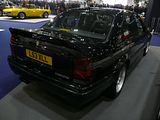

WILLIAMS
After the event, I received an email that declared that the organisers deemed this inaugural event to be a success. I have to agree with them. It was a splendid day out, with plenty to see, and the combination of the various themed displays and the Grand Avenue concept gave it some differentiation to ensure that it will be remembered for being more than “just another rather good Classic Car show”. Over 25,000 people visited this event, but it never felt crowded, and the dealers will be happy as among the notable cars sold off their stands were a £1.5m Ferrari, three £500,000 Aston Martins and a £500,000 E-type Jaguar. Plans are already afoot for the 2016 event, which we are told will be 50% bigger. It takes place from 18 – 21st February 2016. I will be there

